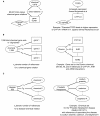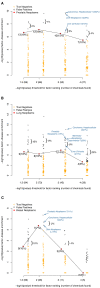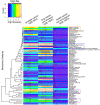Predicting environmental chemical factors associated with disease-related gene expression data
- PMID: 20459635
- PMCID: PMC2880288
- DOI: 10.1186/1755-8794-3-17
Predicting environmental chemical factors associated with disease-related gene expression data
Abstract
Background: Many common diseases arise from an interaction between environmental and genetic factors. Our knowledge regarding environment and gene interactions is growing, but frameworks to build an association between gene-environment interactions and disease using preexisting, publicly available data has been lacking. Integrating freely-available environment-gene interaction and disease phenotype data would allow hypothesis generation for potential environmental associations to disease.
Methods: We integrated publicly available disease-specific gene expression microarray data and curated chemical-gene interaction data to systematically predict environmental chemicals associated with disease. We derived chemical-gene signatures for 1,338 chemical/environmental chemicals from the Comparative Toxicogenomics Database (CTD). We associated these chemical-gene signatures with differentially expressed genes from datasets found in the Gene Expression Omnibus (GEO) through an enrichment test.
Results: We were able to verify our analytic method by accurately identifying chemicals applied to samples and cell lines. Furthermore, we were able to predict known and novel environmental associations with prostate, lung, and breast cancers, such as estradiol and bisphenol A.
Conclusions: We have developed a scalable and statistical method to identify possible environmental associations with disease using publicly available data and have validated some of the associations in the literature.
Figures





Similar articles
-
The Comparative Toxicogenomics Database: update 2011.Nucleic Acids Res. 2011 Jan;39(Database issue):D1067-72. doi: 10.1093/nar/gkq813. Epub 2010 Sep 22. Nucleic Acids Res. 2011. PMID: 20864448 Free PMC article.
-
Comparative Toxicogenomics Database: a knowledgebase and discovery tool for chemical-gene-disease networks.Nucleic Acids Res. 2009 Jan;37(Database issue):D786-92. doi: 10.1093/nar/gkn580. Epub 2008 Sep 9. Nucleic Acids Res. 2009. PMID: 18782832 Free PMC article.
-
Prediction of human genes and diseases targeted by xenobiotics using predictive toxicogenomic-derived models (PTDMs).Mol Biosyst. 2013 Jun;9(6):1316-25. doi: 10.1039/c3mb25309k. Epub 2013 Mar 1. Mol Biosyst. 2013. PMID: 23455869
-
[Toxicogenomics as a tool for evaluation of chemical effects].Yakugaku Zasshi. 2007 Dec;127(12):1967-74. doi: 10.1248/yakushi.127.1967. Yakugaku Zasshi. 2007. PMID: 18057786 Review. Japanese.
-
The Comparative Toxicogenomics Database (CTD): a resource for comparative toxicological studies.J Exp Zool A Comp Exp Biol. 2006 Sep 1;305(9):689-92. doi: 10.1002/jez.a.307. J Exp Zool A Comp Exp Biol. 2006. PMID: 16902965 Free PMC article. Review.
Cited by
-
The Comparative Toxicogenomics Database: update 2011.Nucleic Acids Res. 2011 Jan;39(Database issue):D1067-72. doi: 10.1093/nar/gkq813. Epub 2010 Sep 22. Nucleic Acids Res. 2011. PMID: 20864448 Free PMC article.
-
Extracellular Vesicles in Environmental Toxicological Studies: Association between Urinary Concentrations of Phthalate Metabolites and Exosomal miRNA Expression Profiles.Int J Mol Sci. 2024 Apr 30;25(9):4876. doi: 10.3390/ijms25094876. Int J Mol Sci. 2024. PMID: 38732095 Free PMC article.
-
Annual fasting; the early calories restriction for cancer prevention.Bioimpacts. 2012;2(4):213-5. doi: 10.5681/bi.2012.028. Epub 2012 Dec 21. Bioimpacts. 2012. PMID: 23678462 Free PMC article.
-
The role of cognitive activity in cognition protection: from Bedside to Bench.Transl Neurodegener. 2017 Mar 28;6:7. doi: 10.1186/s40035-017-0078-4. eCollection 2017. Transl Neurodegener. 2017. PMID: 28360996 Free PMC article. Review.
-
NCBI GEO: archive for functional genomics data sets--10 years on.Nucleic Acids Res. 2011 Jan;39(Database issue):D1005-10. doi: 10.1093/nar/gkq1184. Epub 2010 Nov 21. Nucleic Acids Res. 2011. PMID: 21097893 Free PMC article.
References
-
- Schwartz D, Collins F. Medicine. Environmental biology and human disease. Science. 2007;316(5825):695–696. - PubMed

